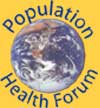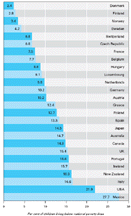 |
Population Health Forum Advocating for Action Toward a Healthier Society |
|
Page Contents What Is Population Health? a href="#policy">Policy Implications TO SUBSCRIBE to the Forum's list, click JOIN and follow the instructions. "We live in a society that favors medical technology over public health. We'd rather pay for the 'pound of cure' than the 'ounce of prevention.' Unfortunately, giving people a new heart is much more glamorous (and expensive, too) than teaching them to take care of the heart they were born with." — Michael Barnes, Send us your comments, questions, and written contributions. |
Population health refers to the most important determinents of the health of populations. We can measure population health by:
What are the most important factors affecting the health of a population? The factors that have the strongest effect on health are, generally, rooted in the society's economic and social relationships. in other words, health care and individual behaviors seem to be less important than societal factors. In studies conducted in the US and other countries, the level of hierarchy in a society appears to be one of the most important factors affecting the health of a population. The greater the difference—or gap—between those on top and those on the bottom in a society, the worse its health appears to be. In the US—where we buy most of the things we need—we can use income distribution as measure of the gap between the richest and poorest. Income inequality and population health Income & health Populations whose income is below a threshold (about $5,000 - $10,000 in US per capita income) generally have poorer health. Increasing income in such societies leads to better health. Above the threshold, national health is not necessarily related to absolute income, but rather to the gap between rich and poor. Studies in the past 15 years found that where income gaps are smaller, health appears to be better. Hierarchy & health Hierarchy refers to ranking by political, economic, and social status. For example, we can think of hierarchy as a ladder. Where we place ourselves on the ladder is one measure of our status. We might consider gender, race, income level, education, successes, occupation, and health when we decide where we fit on the ladder. Some other considerations might be:
Environment & health Societies with smaller extremes of hierarchy appear to care for their physical environment better, and may also have better population health. Environment & children's health In 2000, more than 4.7 million children under the age of five died from illnesses aggravated by unhealthy environments, according to the World Health Organization (WHO). Every two hours as many children die as the total toll of the September 11 attacks. WHO has developed a children's action plan called "Healthy Places, Happy Faces."
Crime & violence Criminologists and sociologists have known for decades that levels of hierarchy predict the amount of violence in a population. The bigger the gap, the more those above supress those below, often with violence. Structural violence Structural violence refers to the excess rates of poor health and death due to poverty. They are structural because they are caused by the social and economic structures of society—decisions made about who gets what. They are violent because they are injuries to people caused by humans. This perspective suggests that one of the leading causes of death in the world is structural violence. Global Health Groups of populations can be ranked by various health indicators, such as life expectancy, infant mortality, and self-assessed health. Rankings can also be made for other measures including education, behaviors, and economic outcomes. Those rankings can provide insight into population health. Some of these rankings are described below, using the Olympics as a metaphor. The concept of the Helath Olympics has been used by the Population Health Forum at the University of Washington to rank countries by life expectancy (using annual United Nations data). As you can see in this list of life expectancy in 187 countries, the US is not winning any medals in the Health Olympics.
Social Cohesion Social cohesion refers to the extent of solidarity among groups in a society and suggests there is mutual moral support. A cohesive society has stocks of social capital. Social Capital The term social capital has been used since 1988. In general, it refers to social (not individual) and public goods, or those features of social structures that facilitate the actions of members within them. We can think of social capital as levels of trust within a social structure, social organizations, norms, sanctions, and information channels. Levels of trust in communities have been linked to hierarchy by Eric Uslaner and to mortality rates by Ichiro Kawachi. Given that the structure of society—the rules governing who gets what share of the resources—has such a profound connection to the health of individuals and groups within that society, these concepts have strong policy implications. In general, we can ask what effects a particular policy, such as cutting taxes on a certain segment of society or subsidizing some industry, will have on the hierarchy in that society and, therefore, on its health considered specifically in terms of mortality rates, and more broadly, in terms of various behaviors and outcomes. Almost all trends today in societies in many parts of the world, are increasing the disparity between the rich and the poor. The health implications are serious. Some populations in the world have life expectancies little different from Ancient Rome; others have unimaginably good health, despite having few resources or advanced medical care. It is difficult to call this progress. Yet many of us who are privileged and some of us who are not, remain profoundly ignorant of this situation. Criticisms of the Hierarchy & Poor Health Relationship We can learn a great deal by understanding critical comments on the hiearchy/poor health relationship. Academic criticisms in the scholarly literature are addressed in the academic bibliography on the Resources page. Some of the few criticisms in the popular press are presented below. Does Inequality Make You Sick? The dangers of the new public health crusade. "Is Our Society Making You Sick ? a "My Turn" editorial that appeared in NEWSWEEK. A commentary on the Newsweek article. |
||||||||||




